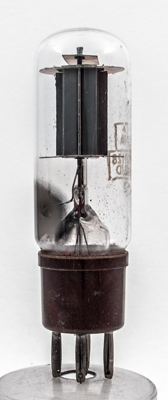The CV1128 thyratron specification was based on the commercial GT1C and had previously been known by other service codes such as the NGT2 and the VGT128.The usual envelope for the GT1C or CV1128 was the classic or shouldered design with a cylindrical anode, this exhibit has a glass tubular envelope and a rectangular anode. Probably this is of later construction for replacement purposes.This thyratron design is from the 1930s and was used in timebases for Radar and television. At a defined grid voltage the valve, will rapidly switch to full conduction. The valve is turned off by reducing the anode voltage. Most thyratrons are gas filled and can be considered as triggered gas discharges. Argon or Xenon was used in the CV1128.The precision of construction gives the defined and reproducible operating characteristics. This valve not only has a high peak current but is designed for operation at up to 8,000 pulses per second.The first computer, Colossus, used these thyratrons as pulse generators. The operating speed of Colossus was 5,000 clock cycles per second clocking being derived from the tape sprocket holes passing a photocell.
The rectangular box anode has two side flanges for additional surface area.The wide glass tube envelope is 30 mm in diameter and, excluding the B5 base pins, is 92 mm tall.References: Data-sheet, 1040 & 1043. Type CV1128 was first introduced in 1937. See also 1937 adverts. |